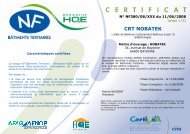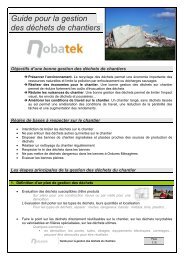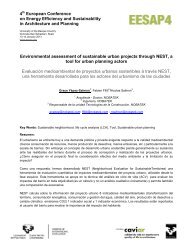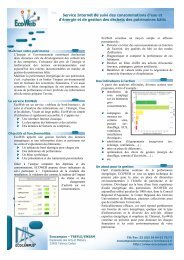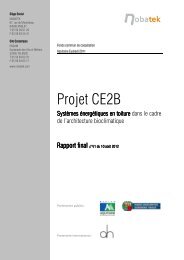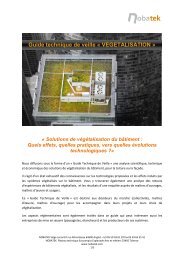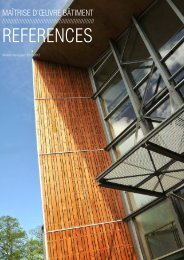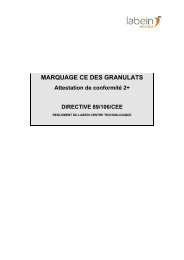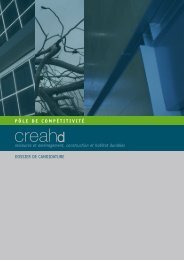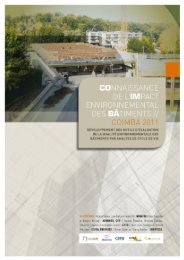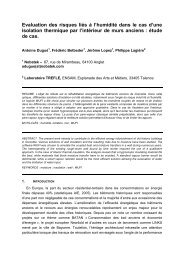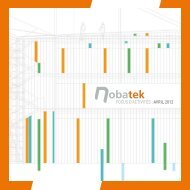THESE Ecoquartier-Outil NEST - Nobatek
THESE Ecoquartier-Outil NEST - Nobatek
THESE Ecoquartier-Outil NEST - Nobatek
Create successful ePaper yourself
Turn your PDF publications into a flip-book with our unique Google optimized e-Paper software.
Abstract<br />
The present work is focused on the current stakes related to the urban environment; it aims at defining<br />
what is a sustainable neighborhood, starting from the study of reference projects and integrating<br />
strongly field process requirements and constraints; Within this framework, environmental<br />
evaluation is positioned in the earth of the neighborhood design process as a tool for decisionmaking<br />
aid, allowing city stakeholders to inscribe their project in the concerns of sustainable urban<br />
development. The finality is to propose a method for evaluating the environmental impact of sustainable<br />
neighborhoods projects in the first design phase.<br />
This thesis is integrated in a CIFRE convention with the <strong>Nobatek</strong> company (technological Center<br />
working on sustainable construction and planning) and the GRECAU laboratory (Group of research<br />
in environment architectural and urban design). It proposes an analysis of the urban practice,<br />
defines the requirements for specific tools for the planning of sustainable urban projects and<br />
proposes a tool for environmental evaluation. The research work here presented is conducted for<br />
pragmatic objectives, as required by the collaboration with the company nobatek, i.e. closed to<br />
the reality of the planning process.<br />
The first part establishes the dependent stakes with town planning and proposes a historical study<br />
of the urban models for the ideal city. It is proposed there a glance on the principles and evolutions<br />
of the concept of ideal city in order to locate and include/understand the concept of sustainable<br />
city. The second part establishes the relevance of the district as the best scale of experimentation<br />
and proposes a definition of the sustainable neighborhood and analyzes various reference<br />
cases through their typologies, their urban form and their technical solutions. The third part<br />
proposes an overview of various tools allowing the analysis of the processes of design and evaluation<br />
of the sustainable neighborhoods. This analysis underlines in particular the non existence of the<br />
“absolute tool”, and concluded with the need to develop particular tools for evaluation, complementary<br />
to those already existing focused on design assistance and based on qualitative approaches.<br />
An analysis of the existing set of indicators is proposed, it shows their utility for an urban<br />
project as well as their limits. The fourth part proposes an analysis of the operational practice of<br />
town planning in the French context and proposes an operational approach of implementation of<br />
sustainability in such process. The latter part introduces the development of the tool for evaluation<br />
called <strong>NEST</strong> which constituted the final part of this work. The tool is based on the technique of life<br />
cycle analysis (ACV) to evaluate the environmental impacts of the district to be created. The<br />
physical elements of the district (buildings, public spaces, green areas, infrastructures), such as<br />
defined in an early phase of the urban project, are integrated in the tool. It calculates then seven<br />
environmental indicators to evaluate the project, these results being brought back to the stakeholders<br />
of the district planning process. An operational experimentation of the process proposed<br />
and the use of the evaluation tool is also eventually presented, based on the ongoing Kleber<br />
neighborhood project in Biarritz (Fr). It shows the contribution of the tool for the design of such district<br />
with the goal to set up there a sustainable neighborhood.<br />
Introducing the concept of sustainable development into town planning requires, in addition to<br />
environmental, social and economic approaches, a technical comprehension of the city and its<br />
urban components, as a closed system which consumes resources and as a consequence generates<br />
impacts. To understand the city as a system, in order to establish objectives and strategies to<br />
manage and transform it to sustainable, requires the implication of the stakeholders involved in the<br />
decision-making, the design and the use of the city. This work brings several hypotheses on the<br />
current possible approaches and proposes pragmatic solutions for the implementation of such<br />
operations.<br />
CONSTRUCTION D‟UN OUTIL D‟EVALUATION ENVIRONNEMENTALE DES ECOQUARTIERS : vers une méthode<br />
systémique de mise en œuvre de la ville durable – Grace Yépez, 2011<br />
4




